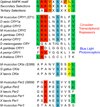AMPK at the crossroads of circadian clocks and metabolism
- PMID: 22750052
- PMCID: PMC3502724
- DOI: 10.1016/j.mce.2012.06.017
AMPK at the crossroads of circadian clocks and metabolism
Abstract
Circadian clocks coordinate behavior and physiology with daily environmental cycles and thereby optimize the timing of metabolic processes such as glucose production and insulin secretion. Such circadian regulation of metabolism provides an adaptive advantage in diverse organisms. Mammalian clocks are primarily based on a transcription and translation feedback loop in which a heterodimeric complex of the transcription factors CLOCK (circadian locomotor output cycles kaput) and BMAL1 (brain and muscle Arnt-like protein 1) activates the expression of its own repressors, the period (PER1-3) and cryptochrome (CRY1 and CRY2) proteins. Posttranslational modification of these core clock components is critical for setting clock time or adjusting the speed of the clock. AMP-activated protein kinase (AMPK) is one of several metabolic sensors that have been reported to transmit energy-dependent signals to the mammalian clock. AMPK does so by driving the phosphorylation and destabilization of CRY and PER proteins. In addition, AMPK subunit composition, sub-cellular localization, and substrate phosphorylation are dependent on clock time. Given the well-established role of AMPK in diverse aspects of metabolic physiology, the reciprocal regulation of AMPK and circadian clocks likely plays an important role in circadian metabolic regulation.
Copyright © 2012 Elsevier Ireland Ltd. All rights reserved.
Figures



Similar articles
-
Circadian repressors CRY1 and CRY2 broadly interact with nuclear receptors and modulate transcriptional activity.Proc Natl Acad Sci U S A. 2017 Aug 15;114(33):8776-8781. doi: 10.1073/pnas.1704955114. Epub 2017 Jul 27. Proc Natl Acad Sci U S A. 2017. PMID: 28751364 Free PMC article.
-
Dual modes of CLOCK:BMAL1 inhibition mediated by Cryptochrome and Period proteins in the mammalian circadian clock.Genes Dev. 2014 Sep 15;28(18):1989-98. doi: 10.1101/gad.249417.114. Genes Dev. 2014. PMID: 25228643 Free PMC article.
-
Quantification of interactions among circadian clock proteins via surface plasmon resonance.J Mol Recognit. 2014 Jul;27(7):458-69. doi: 10.1002/jmr.2367. J Mol Recognit. 2014. PMID: 24895278
-
[Molecular mechanisms of circadian clock functioning].Ukr Biokhim Zh (1999). 2011 May-Jun;83(3):5-24. Ukr Biokhim Zh (1999). 2011. PMID: 21888051 Review. Ukrainian.
-
The Circadian Clock, Nutritional Signals and Reproduction: A Close Relationship.Int J Mol Sci. 2023 Jan 12;24(2):1545. doi: 10.3390/ijms24021545. Int J Mol Sci. 2023. PMID: 36675058 Free PMC article. Review.
Cited by
-
CRY1 circadian gene variant interacts with carbohydrate intake for insulin resistance in two independent populations: Mediterranean and North American.Chronobiol Int. 2014 Jun;31(5):660-7. doi: 10.3109/07420528.2014.886587. Epub 2014 Feb 18. Chronobiol Int. 2014. PMID: 24548145 Free PMC article.
-
Systems Level Understanding of Circadian Integration with Cell Physiology.J Mol Biol. 2020 May 29;432(12):3547-3564. doi: 10.1016/j.jmb.2020.02.002. Epub 2020 Feb 13. J Mol Biol. 2020. PMID: 32061938 Free PMC article. Review.
-
Coupling circadian rhythms of metabolism and chromatin remodelling.Diabetes Obes Metab. 2015 Sep;17 Suppl 1(0 1):17-22. doi: 10.1111/dom.12509. Diabetes Obes Metab. 2015. PMID: 26332964 Free PMC article. Review.
-
Timing of host feeding drives rhythms in parasite replication.PLoS Pathog. 2018 Feb 26;14(2):e1006900. doi: 10.1371/journal.ppat.1006900. eCollection 2018 Feb. PLoS Pathog. 2018. PMID: 29481559 Free PMC article.
-
Circadian Rhythm in Adipose Tissue: Novel Antioxidant Target for Metabolic and Cardiovascular Diseases.Antioxidants (Basel). 2020 Oct 9;9(10):968. doi: 10.3390/antiox9100968. Antioxidants (Basel). 2020. PMID: 33050331 Free PMC article. Review.
References
-
- Asher G, Gatfield D, Stratmann M, Reinke H, Dibner C, Kreppel F, Mostoslavsky R, Alt FW, Schibler U. SIRT1 regulates circadian clock gene expression through PER2 deacetylation. Cell. 2008;134:317–328. - PubMed
-
- Asher G, Reinke H, Altmeyer M, Gutierrez-Arcelus M, Hottiger MO, Schibler U. Poly(ADP-ribose) polymerase 1 participates in the phase entrainment of circadian clocks to feeding. Cell. 2010;142:943–953. - PubMed
-
- Balsalobre A, Brown SA, Marcacci L, Tronche F, Kellendonk C, Reichardt HM, Schutz G, Schibler U. Resetting of circadian time in peripheral tissues by glucocorticoid signaling. Science. 2000;289:2344–2347. - PubMed
Publication types
MeSH terms
Substances
Grants and funding
LinkOut - more resources
Full Text Sources
Other Literature Sources
Research Materials

